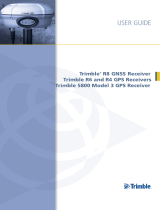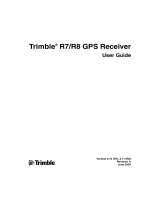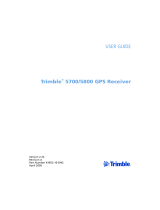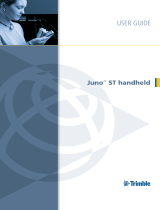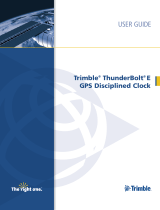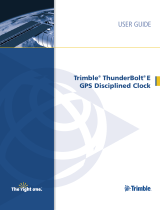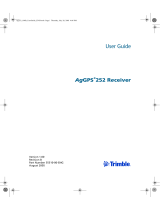
Regulatory information
For full legal and regulatory information, please go to https://receiverhelp.trimble.com/r780-gnss.
USA
FCC Compliance Statement
Model Numbers: R780
FCC IDs: JUPR750M566-90,
JUPR750M566-60
FCC Class B - Notice to Users. This device complies with part 15
of the FCC rules.
RESPONSIBLE PARTY:
Trimble Inc.
10368 Westmoor Drive
Westminster CO 80021
USA
trimble.com/Corporate/Contacts.aspx
This device complies with Part 15 of the FCC Rules. Operation is
subject to the following two conditions: (1) this device may not
cause harmful interference, and (2) this device must accept any
interference received, including interference that may cause
undesired operation. Changes or modications made to this
equipment not expressly approved by Trimble Inc may void the
FCC authorization to operate this equipment.
FCC Certied Modular Transceiver
The TRM900 (902.0 MHz to 928.0 MHz) Limited Singular-
Modular Transceiver is only approved for use by Trimble in its own
GNSS Receiver products and not intended for sale to third parties.
This module is not intended for OEM integrators or end users.
As a Limited Single Module, additional compliance evaluation is
required for use in each of the GNSS Receiver host.
The TRM900 was tested and certied with a monopole antenna
(868MHz-940MHz, 2.5dBi max gain, TPN66540-10). The
connector type was RP-TNC.
The TDL450i (403.0 MHz to 473.0 MHz) Singular-Modular
Transceiver was tested and certied with a monopole antenna
(400MHz-512MHz, -2dBi max gain, TPN44085-60). The
connector type is also RP-TNC.
Canada
This device contains licence-exempt transmitter(s)/receiver(s)
that comply with Innovation, Science and Economic Development
Canada’s licence-exempt RSS(s). Operation is subject to the
following two conditions:
• This device may not cause interference.
• This device must accept any interference, including
interference that may cause undesired operation of the device.
L’émetteur/récepteur exempt de licence contenu dans le présent
appareil est conforme aux CNR d’Innovation, Sciences et
Développement économique Canada applicables aux appareils
radio exempts de licence. L’exploitation est autorisée aux deux
conditions suivantes :
(1) l’appareil ne doit pas produire de brouillage;
(2) l’appareil doit accepter tout brouillage radioélectrique subi,
même si le brouillage est susceptible d’en compromettre le
fonctionnement.
Under Industry Canada regulations, this radio transmitter may
only operate using an antenna of a type and maximum (or lesser)
gain approved for the transmitter by Industry Canada. To reduce
potential radio interference to other users, the antenna type and
its gain should be chosen so that the equivalent isotropically
radiated power (EIRP) is not more than that required for
successful communication.
Conformément à la réglementation d’Industrie Canada, le présent
émetteur radio peut fonctionner avec une antenne d’un type et
d’un gain maximal (ou inférieur) approuvé pour l’émetteur par
Industrie Canada. Dans le but de réduire les risques de brouillage
radioélectrique à l’intention des autres utilisateurs, il faut choisir
le type d’antenne et son gain de sorte que la puissance isotrope
rayonnée équivalente (PIRE) ne dépasse pas l’intensité nécessaire
à l’établissement d’une communication satisfaisante.
This Class B digital apparatus complies with Canadian ICES-003.
Cet appareil numérique de la classe B est conforme à la norme
NMB-003 du Canada.
This apparatus complies with Canadian RSS-GEN, RS-102,
RSS-247.
Cet appareil est conforme à la norme CNR-GEN, CNR-102,
CNR-247 du Canada.
Japan
Ministry of Internal Aairs and Communications
technical conformity
R 201-140447 (BT/WiFi)
R 020-200095 (UHF)
United Kingdom
Hereby, Trimble Inc., declares that the R780
GNSS receiver complies with the following UK
legislations:
• S.I. 2016 No. 1101, Low Voltage, RF Exposure
• S.I. 2016 No. 1091, EMI/EMC
• S.I. 2017 No. 1206, Radio Equipment
South Africa
This product was type approved by the
Independent Communications Authority of South
Africa.
Australia and New Zealand
This product conforms with the regulatory
requirements of the Australian Communications and
Media Authority (ACMA) Radiocommunications Act.
Europe
Hereby, Trimble Inc., declares that the R780 GNSS
receiver complies with the following directives:
• RED 2014/53/EU
• RoHS Directive 2011/65/EU
• WEEE Directive 2012/19/EU
CE marking
The products covered by this guide may be operated in all
EU member countries (BE, BG, CZ, DK, DE, EE, IE, EL, ES, FR,
HR, IT, CY, LV, LT, LU, HU, MT, NL, AT, PL, PT, RO, SI, SK, FI, SE,
UK), Great Britain (England, Wales, Scotland), Norway and
Switzerland. Products been tested and found to comply with the
requirements for a Radio Equipment device pursuant to European
Council Directive 2014/53/EU on EMC, thereby satisfying the
requirements for CE Marking and sale within the European
Economic Area (EEA). Contains a Bluetooth radio module. These
requirements are designed to provide reasonable protection
against harmful interference when the equipment is operated in a
residential or commercial environment.
Recycling
For product recycling instructions and more
information, go to www.trimble.com/en/our-
commitment/responsible-business/corporate-
compliance/environmental-compliance.
Trimble R780
GNSS RECEIVER
Battery door
Lemo port
Front panel
TNC radio
antenna
connection
For Bluetooth radio
The radiated output power of the internal Bluetooth wireless radio and the Wi-Fi radio included in some Trimble
receivers is far below the FCC radio frequency exposure limits. Nevertheless, the wireless radio(s) shall be used in such
a manner that the Trimble receiver is 25 cm or further from the human body. The internal wireless radio(s) operate
within guidelines found in radio frequency safety standards and recommendations, which reect the consensus of the
scientic community. Trimble therefore believes that the internal wireless radio(s) are safe for use by consumers. The
level of energy emitted is far less than the electromagnetic energy emitted by wireless devices such as mobile phones.
However, the use of wireless radios may be restricted in some situations or environments, such as on aircraft. If you
are unsure of restrictions, you are encouraged to ask for authorization before turning on the wireless radio.
Installing antennas
CAUTION – For your own safety, and in terms of the RF exposure requirements of the FCC, always observe
these precautions:
- Always maintain a minimum separation distance of 47 cm (18.5 inches) between yourself and the radiating
antenna
- Do not co-locate the antenna with any other transmitting device
WARNING – The GNSS and its cabling should be installed in accordance with all national and local electrical
codes, regulations, and practices. The cabling should be installed where they will not become energized as a result
of falling nearby power lines, nor be mounted where they are subjected to over-voltage transients, particularly
lightning. Such installations require additional protective means that are detailed in national and local electrical
codes.
Trimble receiver internal radios have been designed to operate with the antennas listed below. Antennas not
included in this list are strictly prohibited for use with this device. The required antenna impedance is 50 ohms.
To reduce potential radio interference to other users, the antenna type and its gain should be an approved Trimble
antenna, so that the equivalent isotropically radiated power (e.i.r.p.) is not more than that permitted for successful
communication.
7 98
Trimble Inc.
10368 Westmoor Drive
Westminster CO 80021
USA
© 2022, Trimble Inc. All rights reserved. Trimble, and the Globe & Triangle logo are
trademarks of Trimble, registered in the United States and in other countries. All other
trademarks are the property of their respective owners. P/N 129311-00, Rev A(02/22).
*129311-00* trimble.com
R780_RevA_QuickStartGde_129311-00_eng.indd 7-8,11R780_RevA_QuickStartGde_129311-00_eng.indd 7-8,11 10/03/2022 9:59:12 AM10/03/2022 9:59:12 AM





